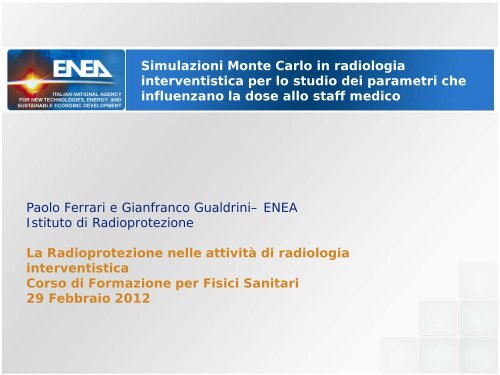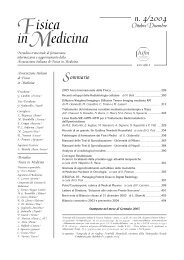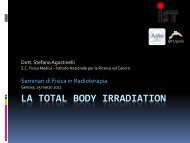Simulazione Montecarlo in radiologia interventistica per lo studio dei ...
Simulazione Montecarlo in radiologia interventistica per lo studio dei ...
Simulazione Montecarlo in radiologia interventistica per lo studio dei ...
- No tags were found...
You also want an ePaper? Increase the reach of your titles
YUMPU automatically turns print PDFs into web optimized ePapers that Google loves.
ORAMED CONSORTIUM PARTNERS
WP1• Partecipanti: GAEC (GR), SCK (B), ENEA (I), IRSN (F),CHUV (S), SMU (SL), NIOM (PL)• Procedure considerate: 3 cardiache - cardiacangiographies (CA) and angioplasties (PTCA),radiofrequency ablations (RFA), pacemaker implantations(PM) - 5 generali di <strong>in</strong>terventistica diagnostica eterapeutica - angiographies (DSA) and angioplasties (PTA)of the <strong>lo</strong>wer limbs (LL), the carotids (C) and renal (R),embolisations and endoscopic retrogradecholangiopancreatographies (ERCP).
Sensori <strong>per</strong> Hp(0.07) e Hp(3)
scor<strong>in</strong>gdxtran-- - - PseudoparticlessourceThe radius of the sphere was evaluated as:mean free path <strong>in</strong> muscle for a 50keV photonAnd 50 keV is the mean energy of the 80kVpspectrum used here.
Direzione di <strong>in</strong>gresso del fascio RXAPAPRAO 90RAOLAO 90LAOPACRANPACAUDLe valutazioni di dose sono state normalizzate rispetto alla dose <strong>in</strong> <strong>in</strong>gresso al sistemadi imag<strong>in</strong>g.
Dose all’<strong>in</strong>tensificatore<strong>per</strong> proiezione PA( Gy/nps)KAP (Gy .cm 2 /nps)
Esame zona craniale
Dose <strong>in</strong> <strong>in</strong>gresso all’<strong>in</strong>tensificatore (normalizzata rispetto al caso PA)Esami della testa1- simmetria LAO/RAO2- dose maggiore a II nel caso dell’<strong>in</strong>cidenza parietale (forma ellittica del model<strong>lo</strong>)3- variabilità 0,7 – 2,480 kVp 3 mmAl 0 mmCu (HVL = 3,06 mm Al)KAP (Gy·cm 2 /nps) 5,02E-13
Dose (normalizzata rispetto alla dose <strong>in</strong> <strong>in</strong>gresso II) – ESAME TESTA80 kVp 3 mmAl 0 mmCu (HVL = 3,06 mm Al) NO SCHERMISINISTRODESTRO
Esame zona addome
Dose <strong>in</strong> <strong>in</strong>gresso all’<strong>in</strong>tensificatore (normalizzata rispetto al caso PA)Esami dell’addome1- simmetria LAO/RAO2- dose m<strong>in</strong>ore a II nel caso dell’<strong>in</strong>cidenza laterale3- variabilità 0,01 - 180 kVp 3 mmAl 0 mmCu (HVL = 3,06 mm Al)KAP (Gy·cm 2 /nps) 5,11 E-13
Dose (normalizzata rispetto alla dose <strong>in</strong> <strong>in</strong>gresso II) – ESAME ADDOME80 kVp 3 mmAl 0 mmCu (HVL = 3,06 mm Al) NO SCHERMISINISTRODESTRO
Esame zona torace
Dose <strong>in</strong> <strong>in</strong>gresso all’<strong>in</strong>tensificatore (normalizzata rispetto al caso PA)Esami del torace1- simmetria LAO/RAO , CAUD/CRAN2- dose m<strong>in</strong>ore a II nel caso dell’<strong>in</strong>cidenza laterale3- variabilità 0,05 - 380 kVp 3 mmAl 0 mmCu (HVL = 3,06 mm Al)KAP (Gy·cm 2 /nps) 5,02 E-13
Dose (normalizzata rispetto alla dose <strong>in</strong> <strong>in</strong>gresso II) – ESAME TORACE80 kVp 3 mmAl 0 mmCu (HVL = 3,06 mm Al) NO SCHERMISINISTRODose maggioreDESTRO
Dimensione del campo – ESAME TORACEEsami del toraceRapporto tra le dosi nel caso di campo di diametro 30 cm rispetto a quelle ottenutecon campo di 20 cm <strong>per</strong> i “sensori” posti sul lato s<strong>in</strong>istro (90 kVp 3,5 mm Al).
Accesso – ESAME TORACE
Accesso radiale/femorale – ESAME TORACEAUMENTO DI DOSE NELCASO RADIALESINISTROEsami del toraceRapporto tra le dosi nel casodi “accesso radiale (26 cmdall’asse RX)” rispetto alcaso “femorale (71 cmdall’asse RX)”(70 kVp HVL 2,7mm Al).DESTRO
Schermature
Studio delle schermature mobili
Studio delle schermature mobili – PROTEZIONE DELLA MANO
Studio delle schermature mobili – PROTEZIONE DELL’AVAMBRACCIO
Studio delle schermature mobili – PROTEZIONE DELLE GAMBEEffetto della schermaturaposta sotto al lett<strong>in</strong>o portapaziente.DIMINUZIONE DELLA DOSENEI SENSORI POSTI NELLAZONA DELLE GAMBE
PROTECTIVE LENSESSmall lenses(the same shapeis valid forthicker lens)Large lenses(the same shape is valid forheavy lens)
90 kVpBeam a<strong>per</strong>ture 20 cm diameter3 mm Al 0 mm CuDoses to the eyes (normalized by Exit dose) fordifferent Pb lenses.The “l<strong>in</strong>ear surface” is2.5 larger <strong>in</strong> case oflarge lensLeft eyeRatio with nolenses caseRight eyeRatio with nolenses casePA No lenses 1 1PA Small lens (0.5 mm Pb) 0.30 1PA Large lens (0.5 mm Pb) 0.15 1PA Thick lens (1.0 mm Pb) 0.26 1PA Heavy (larger and thicker) 0.14 1CRA20No lenses 1 1CRA20Small lens (0.5 mm Pb) 0.28 1CRA20Large lens (0.5 mm Pb) 0.14 0.8CRA20Thick lens(1.0 mm Pb) 0.25 1CRA20Heavy (larger and thicker) 0.13 0.8
Bibliografia:RADIATION MEASUREMENTSVOLUME 46 Issue 11November 2011Special IssueInternational Workshop on Optimization of RadiationProtection of Medical Staff, ORAMED 2011La maggior parte del materiale è stata tratta dallapresentazione di C. Koukorava et al.www.oramed-fp7.eu
Grazie <strong>per</strong> la cortese attenzione
















